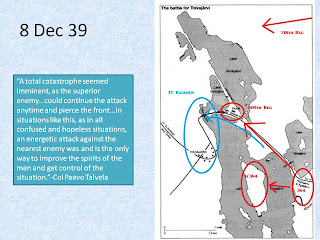The following slides are from my Battle Analysis this semester. The picture in the first slide is from the cover of the game "A Frozen Hell" and the black and white maps are modified from the book "The Winter War: Russia’s Invasion of Finland, 1939-1940" by Robert Edwards. The terrain map is also from the war game. A great deal of the statistics are quotes from his book. The only material that is mine is the analysis and the slide arrangement. This paragraph is only to explain up front which material is mine and which isn't.
"Irg" pretty much was the same as National Guard or Militia Units. They had almost no combat experience before this war and were drawn up only as Finland slowly realized how screwed they were.
The Russian advance seemed at this point to be completely unstoppable. There was simply too many men, too little supplies and no fortifications to stop them.
This is NASTY terrain. Horrendous. Here as an interlude are some pictures from the internet about this terrain:



And here we have our heroes running for their lives, throwing up feeble resistance and retreating across that tiny little land bridge.
It doesn't do much good. Cheerily here come the Russians and drive the Finns from the peninsula, the large island in the middle of the lake and to the far side of the lake.
LTC Pajarvi was a bad-ass. I am in awe of the man. He had a weak heart, he suffered from like 3 near heart attacks in this week long battle and yet he kept pushing himself to the bring of exhaustion making absolute certain that his men were in the right place with the right attitude at the exactly right time.
His night raids completely destroyed Russian morale and organization while giving the Finnish troops some good news for a change.
The Russian troops were in poor morale to start with. I mean hell, they had been told they would be welcomed by throngs of cheering communist sympathizers....not sniped at by the White Death, while trudging through waste high snow along booby trapped roads that cross the ice swamps that time forgot.
Then all of a sudden they smell sausage dinner and flip off their leaders and go eat something warm for a change.
And here you get to see LTC Pajari again. A Russian REGIMENT has just stormed his soup kitchen flanking his defensive force and cutting him off from his relief. What does he do? He grabs a rifle and about 100 of his staff and they pin the REGIMENT in place until his relief can arrive. This is less than 24 hours after he personally led a midnight raid across a frozen fog covered lake against an enormous Russian force.
And here is where the tide turns. You know in movies where the good guys see some improbable hero stand up and charge the enemy and they all expect him to die...but he doesn't? He survives just long enough that they begin to realize they might stand a chance? That is exactly what frail ol'Pajari did. And his men start to respond.
They drive back the regiment eating their dinner. A young LT grabs a company and decides to ambush a battalion and succeeds.
The center position holds against a belated attack from the main Russian force.
And then the next day Talvela and Pajari counter attack and drive the Russians back. Once they start to retreat back the route is on.
Edwards described the victory as this:
"...for a scratch unit, hastily assembled and critically short of equipment, to have routed and effectively annihilated two entire Soviet divisions was a feat of arms unparalleled in modern war, indeed it more properly belonged in the same order of importance as Thermopylae".
This bit is only to explain the analysis to follow.
And there you have it. Hopefully this will make you intrigued enough to read Edward's book or play the game. I enjoyed them both and learned a lot that I had never even heard of before playing this game.













Comments